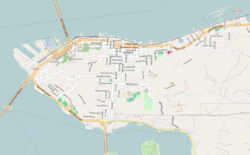
Astoria is a port city and the seat of Clatsop County, Oregon, United States. Founded in 1811, Astoria is the oldest city in the state and was the first permanent American settlement west of the Rocky Mountains. The county is the northwest corner of Oregon, and Astoria is located on the south shore of the Columbia River, where the river flows into the Pacific Ocean. The city is named for John Jacob Astor, an investor and entrepreneur from New York City, whose American Fur Company founded Fort Astoria at the site and established a monopoly in the fur trade in the early 19th century. Astoria was incorporated by the Oregon Legislative Assembly on October 20, 1856.

Clatsop County is one of the 36 counties in the U.S. state of Oregon. As of the 2020 census, the population was 41,072. The county seat is Astoria. The county is named for the Clatsop tribe of Native Americans, who lived along the coast of the Pacific Ocean prior to European settlement. Clatsop County comprises the Astoria, OR Micropolitan Statistical Area, or Sunset Empire, and is located in Northwest Oregon.

The Oregon Historical Society(OHS) is an organization that encourages and promotes the study and understanding of the history of the Oregon Country, within the broader context of U.S. history. Incorporated in 1898, the Society collects, preserves, and makes available materials of historical character and interest, and collaborates with other groups and individuals with similar aims. The society operates the Oregon History Center that includes the Oregon Historical Society Museum in downtown Portland.

The Columbia River Maritime Museum is a museum of maritime history in the northwest United States, located about ten miles (16 km) southeast of the mouth of the Columbia River in Astoria, Oregon.
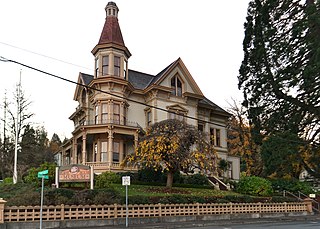
The Captain George Flavel House Museum known also as Capt. George Flavel House and Carriage House or the Flavel Mansion, is now a house museum in Astoria, Oregon, United States. It was built in 1885 in the Queen Anne architectural style, by George Flavel, a Columbia River bar pilot who was one of the area's first millionaires.
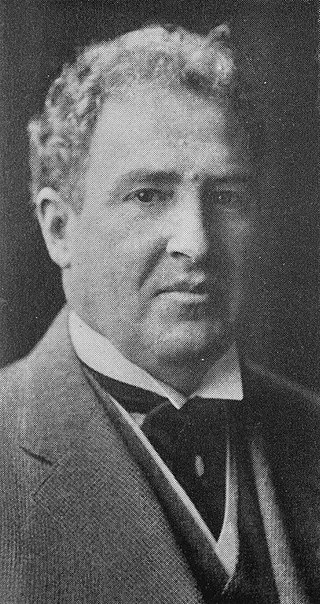
John Virginius Bennes was an American architect who designed numerous buildings throughout the state of Oregon, particularly in Baker City and Portland. In Baker City he did an extensive redesign of the Geiser Grand Hotel, designed several homes, and a now-demolished Elks building. He moved to Portland in 1907 and continued practicing there until 1942.

The United States Post Office in Astoria, Oregon, United States, is a historic building constructed in 1933. It is a two-story building on a raised basement. Its exterior dimensions are 79 by 137 feet. Its 11-bay front facade is divided by flat fluted pilasters with Corinthian capitals supporting a full entablature, with a balustraded parapet above, and a red-tiled hipped roof rising behind that. Its foundations had to be blasted by dynamite.
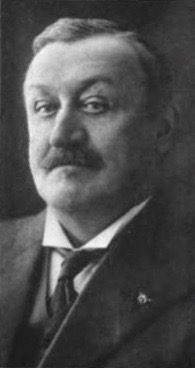
Emil Schacht was an architect in Portland, Oregon. Schacht's work was prolific from the 1890s until World War I and he produced commercial buildings including factories and warehouses as well as residential projects, hotels and theatres. He is known for his craftsman architecture style homes and was a founding member of the 1902 Portland Association of architects.

The Oregon Film Museum is a museum highlighting and celebrating movies that were made in the U.S. state of Oregon. The museum is housed in the old Clatsop County Jail in Astoria, Oregon, which is on the National Register of Historic Places. The building was used in the opening chase sequence of the 1985 film The Goonies. The museum opened in 2010, coinciding with the 25th anniversary of the film.

The John Jacob Astor Hotel, originally known as the Hotel Astoria, is a historic former hotel building located in Astoria, Oregon, United States, and listed on the National Register of Historic Places (NRHP). It is one of the tallest buildings on the Oregon Coast and is a "prominent landmark" in Astoria. Constructed in 1922–23, the hotel opened in 1924 and initially was the city's social and business hub, but soon was beset with a variety of problems, and struggled financially for years. It was renamed the John Jacob Astor Hotel in 1951, but a decline in business continued, as did other problems. The building was condemned by the city for safety violations in 1968 and sat vacant for several years until 1984, when work to renovate it and convert it for apartments began. It reopened as an apartment building in 1986, with the lowermost two floors reserved for commercial use. The building was listed on the NRHP in 1979. The world's first cable television system was set up in 1948 using an antenna on the roof of the Hotel Astoria.
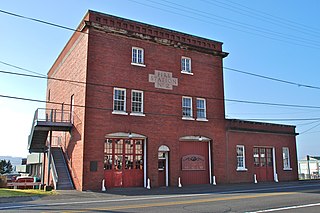
The Astoria Fire House No. 2, also known originally as the North Pacific Brewing Company Beer Storage Building and as the Uppertown Firefighter's Museum since 1989, is a historic building located in Astoria, Oregon, United States.

The Astoria Victory Monument, also known as the Doughboy Monument or Soldiers' Monument, is a monument located in Astoria, Oregon, in the United States. It is listed on the National Register of Historic Places. The concrete, Spanish Revival monument designed by Charles T. Diamond was constructed in 1926, incorporating a cast of a sculpture by John Paulding. The structure was recognized individually by the National Register of Historic Places in 1984 and as part of the Uniontown–Alameda Historic District in 1988.

The Albert W. Ferguson House is a house located in Astoria, Oregon, listed on the National Register of Historic Places.

The Astoria Riverfront Trolley is a 3-mile (4.8 km) heritage streetcar line that operates in Astoria, Oregon, United States, using former freight railroad tracks along or near the south bank of the Columbia River, with no overhead line. The service began operating in 1999, using a 1913-built streetcar from San Antonio, Texas. As of 2012, the service was reported as carrying 35,000 to 40,000 passengers per year and has been called a "symbol" and "icon" of Astoria. The line's operation is seasonal, normally during spring break and from May through September.
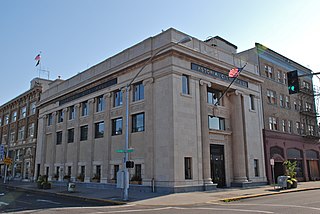
Astoria City Hall is the current city hall for the town of Astoria, Oregon, United States. Built in 1923 to house a bank, the building became the city hall in 1939, and it has remained Astoria's seat of government for more than 75 years.
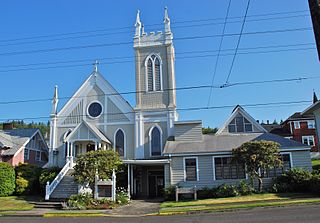
Grace Episcopal Church, also referred to as Grace Episcopal Church and Rectory in the context of historic preservation, is a church, historic church building, and accompanying parsonage, all located in Astoria, Oregon, United States.

Captain George Edward Flavel was an Irish American maritime pilot and entrepreneur. Born in 1823 to Irish parents, Flavel relocated to the West coast of the United States in 1849, working as a tugboat operator between Sacramento and San Francisco, California. In 1851, he settled in the northern coastal port city of Astoria, Oregon, where he became one of the first licensed bar pilots in the state.
Carl W. Leick was an architect who worked in the Northwest of the United States. He designed structures for 25 sites on the West Coast, including the Turn Point (1893), Patos (1908), and Lime Kiln (1914) lighthouses.

